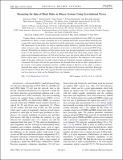Measuring the Spin of Black Holes in Binary Systems Using Gravitational Waves
Author(s)
Vitale, Salvatore; Veitch, John; Raymond, Vivien; Sturani, Riccardo; Lynch, Ryan Christopher
DownloadPhysRevLett.112.251101.pdf (555.2Kb)
PUBLISHER_POLICY
Publisher Policy
Article is made available in accordance with the publisher's policy and may be subject to US copyright law. Please refer to the publisher's site for terms of use.
Terms of use
Metadata
Show full item recordAbstract
Compact binary coalescences are the most promising sources of gravitational waves (GWs) for ground-based detectors. Binary systems containing one or two spinning black holes are particularly interesting due to spin-orbit (and eventual spin-spin) interactions and the opportunity of measuring spins directly through GW observations. In this Letter, we analyze simulated signals emitted by spinning binaries with several values of masses, spins, orientations, and signal-to-noise ratios, as detected by an advanced LIGO-Virgo network. We find that for moderate or high signal-to-noise ratio the spin magnitudes can be estimated with errors of a few percent (5%–30%) for neutron star–black hole (black hole–black hole) systems. Spins’ tilt angle can be estimated with errors of 0.04 rad in the best cases, but typical values will be above 0.1 rad. Errors will be larger for signals barely above the threshold for detection. The difference in the azimuth angles of the spins, which may be used to check if spins are locked into resonant configurations, cannot be constrained. We observe that the best performances are obtained when the line of sight is perpendicular to the system’s total angular momentum and that a sudden change of behavior occurs when a system is observed from angles such that the plane of the orbit can be seen both from above and below during the time the signal is in band. This study suggests that direct measurement of black hole spin by means of GWs can be as precise as what can be obtained from x-ray binaries.
Date issued
2014-06Department
Massachusetts Institute of Technology. Department of Physics; MIT Kavli Institute for Astrophysics and Space ResearchJournal
Physical Review Letters
Publisher
American Physical Society
Citation
Vitale, Salvatore, Ryan Lynch, John Veitch, Vivien Raymond, and Riccardo Sturani. “Measuring the Spin of Black Holes in Binary Systems Using Gravitational Waves.” Physical Review Letters 112, no. 25 (June 2014). © 2014 American Physical Society
Version: Final published version
ISSN
0031-9007
1079-7114